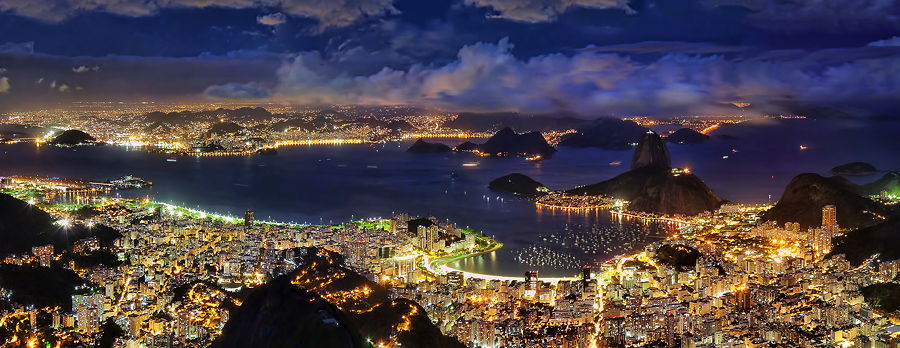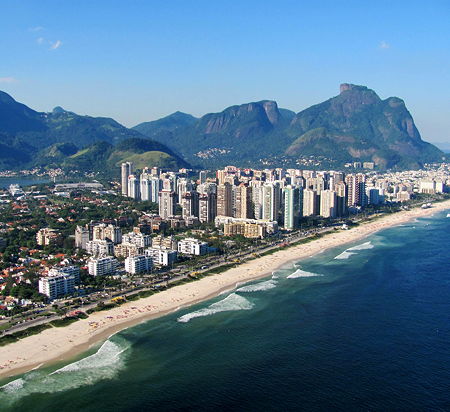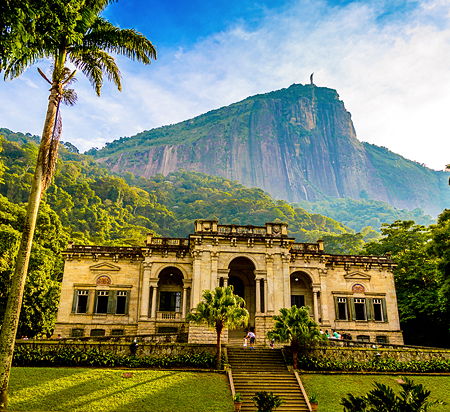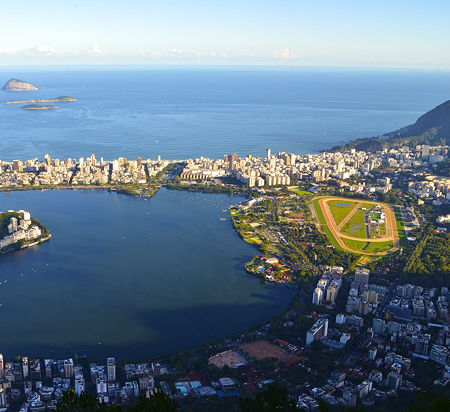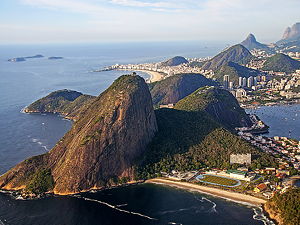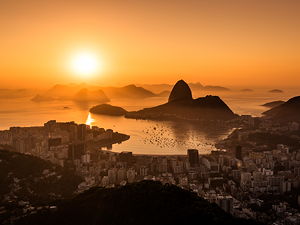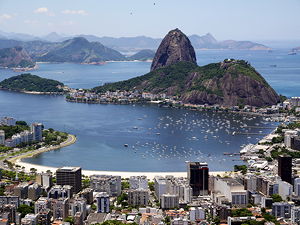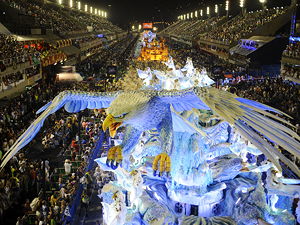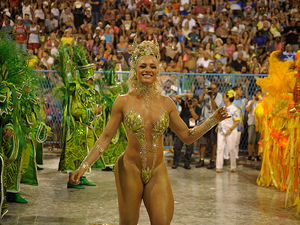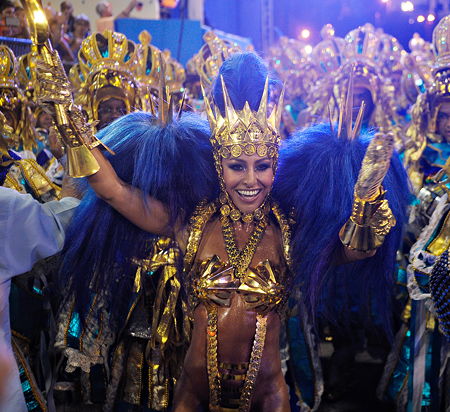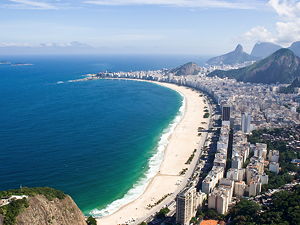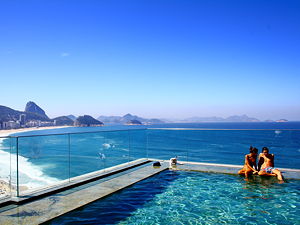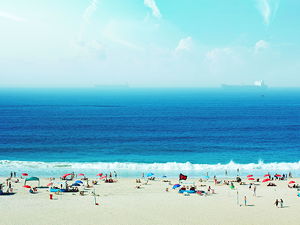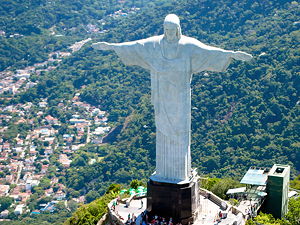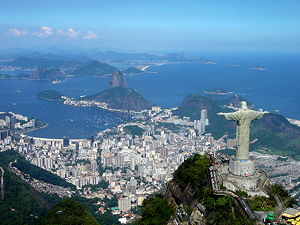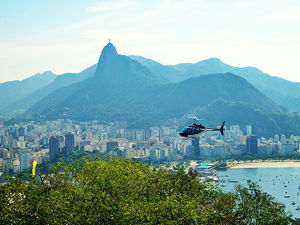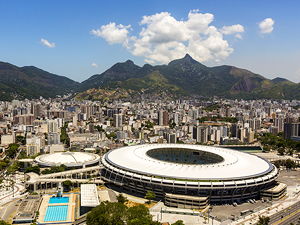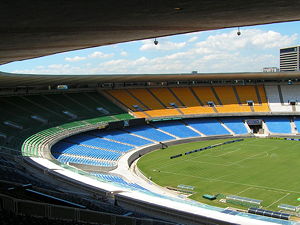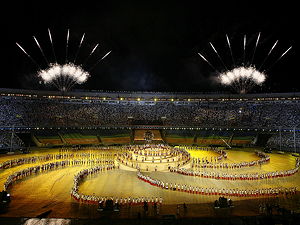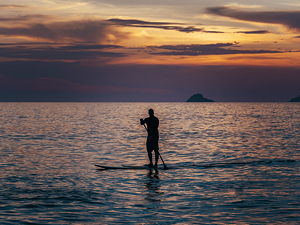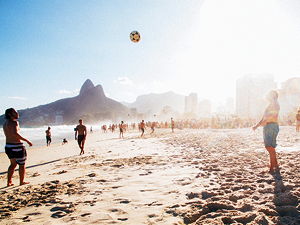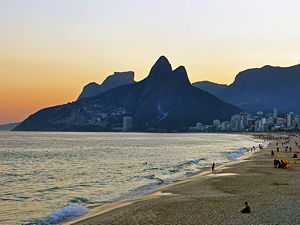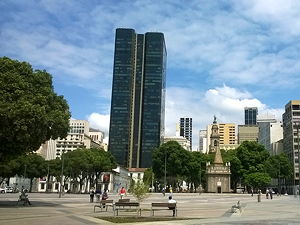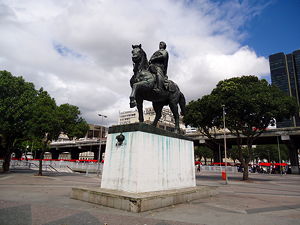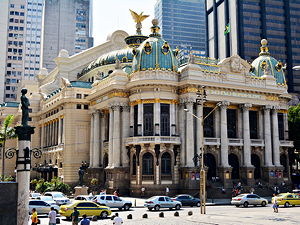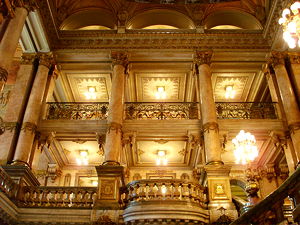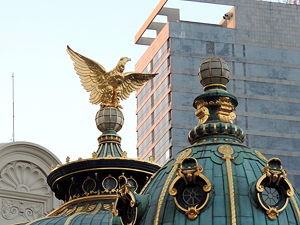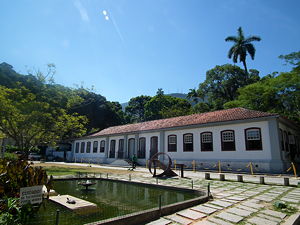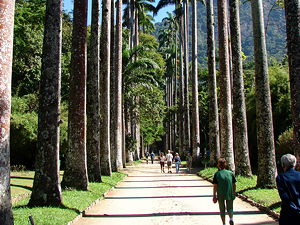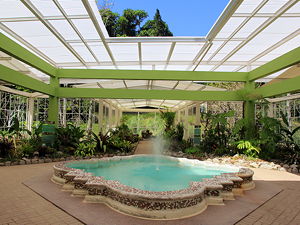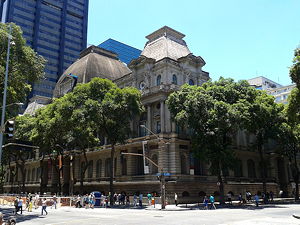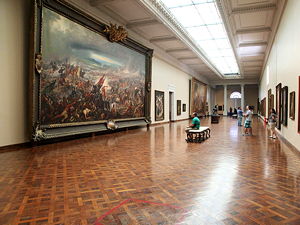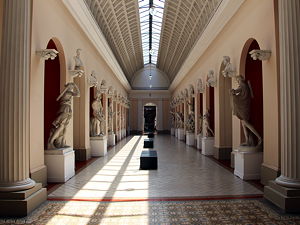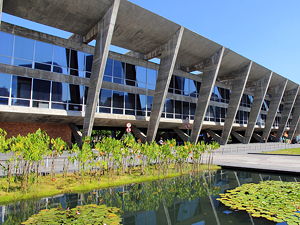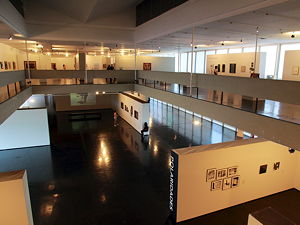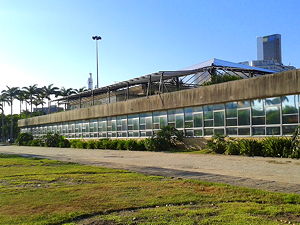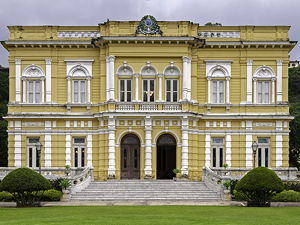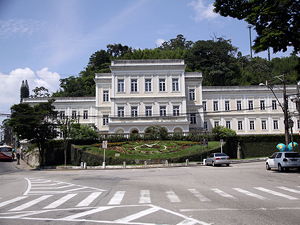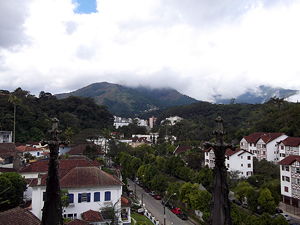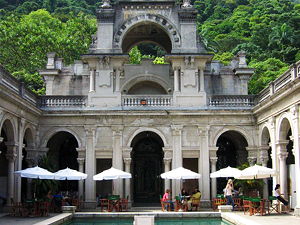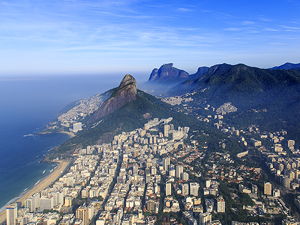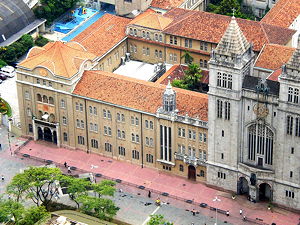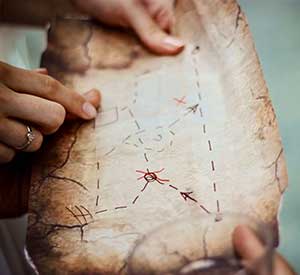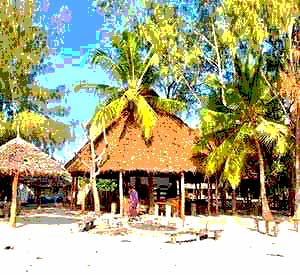Things to do in Rio de Janeiro, Brazil
Rio de Janeiro is home to 6.3 million people, making it the country's second largest city. Formerly the nation's capital, Rio retains its crown as Brazil's top tourist attraction.
Rio has fantastic weather, with average highs exceeding 25 degrees year round, and sea temperatures of over 25 degrees between December and April. Then comes Rio's natural beauty, with the golden sands of world-famous beaches like Copacabana and Ipanema, the turquoise blue of the Atlantic and the rugged peaks of Sugarloaf Mountain and Corcovado.
Next is Rio's atmosphere, most intense during the annual Carnival: these people know how to have a good time. Other attractions include the iconic Christ the Redeemer, world-class art museums, botanical gardens and theatres, and the nearby mountain town of Petropolis, the former retreat of Brazil's monarchy.
The world has noticed: the Pope celebrated World Youth Day on Copacabana beach in July 2013; the 2014 FIFA world cup held its final at Rio's Maracana Stadium (though unfortunately Brazil had been eliminated); and the city hosted the 2016 Olympic Games.
Here are Rio's best attractions and things to do.
1. Sugarloaf Mountain (Pão de Açúar)
Sugarloaf Mountain (Pão de Açúar) is a quartz and granite peak found on a small peninsula protruding into the mouth of Rio's Guanabara Bay.
Rising 396 metres (1,299 ft) above the harbour, Sugarloaf resembles the traditional shape of concentrated refined loaf sugar. From the summit, visitors can take in magnificent views over Rio, its surrounding beaches (including Copacabana and Ipanema), the nearby Corcovado and Tijuca, and the Atlantic ocean. This is, then, a great place to get your bearings.
Sugarloaf's summit is reached by a glass-walled cable car that has been in operation since 1912, and can transport 1360 passengers per hour. Visitors first ascend to the top of Urca Hill (aka Morro da Urca, 220 metres), a flat summit with bars, restaurants and a theatre. You then change cable cars to reach Sugarloaf's summit.
Alternatively, the summit can be achieved on foot from the back of the mountain (though this is only for serious hikers); the lower trails are a great spot to see marmosets. Sugarloaf features in the 1979 James Bond movie, Moonraker, where the henchman Jaws attempts to kill Bond (played by Roger Moore) on the mountain's cable car.
Sugarloaf mountain is one of Rio's most popular attractions, and a great family day out. Don't forget your camera!
where? The first cablecar station is found at Av Pasteur 520, Praia Vermelha, Urca. Take buses 107, 500, 511 or 512 from Centro, Flamengo and Botafogo. MAP
when? Cablecars run from about 8 am to 9 pm.
£$€¥ The cable car costs R$116 for adults, and R$58 for those aged 6-21 with id. Children under 6 go free.
2. The Rio Carnival
The Rio Carnival, the largest in the world, is an annual five-day celebration of samba, music and colour held 40 days before Easter.
The Carnival dates from 1850 and attracts around 500,000 foreign visitors each year. It is undoubtedly Rio's most exciting, vibrant and intoxicating attraction.
The main event is the Samba Parade, which is both a spectacle and a contest between Rio's Samba schools (social clubs found in Rio's poorer communities). Each school prepares a number of elaborate and colourful floats (two are pictured), decorated by giant puppets, and accompanied by 3000 to 5000 gregariously dressed dancers and the school's brass samba band.
The float and dancers follow the school's Porta Bandeira (standard bearer, usually dressed in 18th century formal wear) and Mestre Sala (dance master). The aim is for each school's entry to tell a story. There are 12 principal samba schools, with the Portela, Mangueira and Grande Rio clubs having won the most carnival titles.
Alongside the Samba Parade are any number of street festivals, the most famous being held at Copacabana Palace and beach, which offer dancing, music and partying in large measure.
where? The subway runs round-the-clock on carnival days and allows you to get very close to the Sambodromo or Sambadrome Marquês de Sapucaí (a 700 metre stretch or street lined with stands capable of housing 90,000 spectators, where the Samba Parade culminates). Those with seats in even-numbered sectors should get off at "Praça Onze" station, and those with odd-numbered seats should alight at "Central" station. MAP
when? The 2020 the Carnival will take place between 21 and 26 February 2020.
£$€¥ Allocated tickets to the grandstands which give the best views of the Samba Parade cost between $100 and $500.
3. The Copacabana Beach
Copacabana is a region of south Rio best known for its 4km sandy beach.
This curving beach stretches from Posto Dois (lifeguard watchtower two) to Posto Seis (lifeguard watchtower six). It is surrounded by bars, hotels, restaurants and nightclubs, and offers stunning views over the mountains which surround Rio.
Copacabana is a wonderful place to people-watch, play football or beach volleyball, and soak up the rays (with average maximum temperatures of over 27 degress celcius between December and April).
The water quality, however, attracts many negative comments, with some advising against swimming.
Copacabana hosts the world beach volleyball championships and the FIFA beach soccer world cup. It is also the venue of Rio's wildest New Year's Eve celebrations, in honour of Yemanjá, goddess of the sea.
Music events held at the beach also attract huge crowds: Lenny Kravitz drew over 300,000 on a Monday in March 2005, a 2006 Rolling Stones gig was attended by over 1.5 million, and the 2007 Live Earth concert attracted 400,000, and Rod Stewart sang in the 1995 new year in front of 3.5 million.
Most recently, in July 2013, Pope Benedict XVI held a night-long vigil on Copacabana beach to mark the end of World Youth Day, attracting about 2 million.
Other sites of interest include
- the 17th century chapel in honour of Our Lady of Copacabana (built by the grateful captain of a Spanish galleon after surviving a storm),
- the Forte de Copacabana (built at the south end of the beach in 1914, now housing the Museum of Army History), and
- the famous Copacabana Palace Hotel (whose guests have included Queen Elizabeth II, Madonna, Pavarotti and Marilyn Monroe).
where? Copacabana is a region in south Rio. The closest metro stations are Siqueira Campos and Cardeal Arcoverde. MAP
when? Whilst the beach is used year-round, the hottest months are December to April. The beach can get crowded at weekends; but then again it is the most famous beach in the world and one of Rio's best things to do.
£$€¥ Free.
4. Christ the Redeemer and Corcovado
Declared one of the seven wonders of the modern world in 2007, Christ the Redeemer (Cristo Redentor) is a giant statue of Jesus Christ towering over Rio.
Christ the Redeemer is found at the top of Corcovado mountain (meaning 'hunchback', 2,329 ft) in Rio's Tijuca Forest National Park. It attracts over 300,000 visitors each year, hoping for spectacular views over Rio (for which good weather is essential).
Constructed in France between 1922 and 1931, the statue is 130 ft tall, 98 ft wide, and weighs over 600 tons; it is mounted on a 26 foot high plinth containing a small chapel, and is thought to be the largest Art Deco statue in the world.
The statue, designed by sculptor Paul Landoviski and built by the engineer Heitor da Silva Cost, is both a religious monument and also a major tourist destination offering spectacular panoramic views over Rio and the Serra do Orgaos mountain range. Famous visitors include Pope John Paul II, Pope Pius XII and Albert Einstein.
The surrounding 32 square kilometre Tijuca Forest National Park contains numerous natural springs, waterfalls and over 200 species of bird.
where? From the Cosme Velho station (Rua Cosme Velho 513 Cosme Velho RJ), trains leave every 30 minutes to take the 20 minute journey to the statue. There is no longer any need for tourists to climb the 220 steps to the foot of the statue from the train station: escalators and evalators were installed in 2003. MAP
when? Trains run daily from 8am to 7pm, but capacity is severely limited and so be prepared to wait at peak times. An alternative is to take a taxi.
£$€¥ The train price is R$67-82 depending on the season for adults. Children aged 5-11 cost R$52. Under-5s travel for free.
5. The Maracana Stadium
The Maracana Stadium (Estádio do Maracanã) was built between 1948 and 1950 to host the 1950 FIFA World Cup.
Officially named after journalist Mario Filho, who was instrumental in gathering public support for the project, the elliptical stadium recently hosted the 2014 World Cup Final.
The Maracana Stadium's inauguration saw Brazil defeat Mexico 4 - 0 on 24 June 1950. But underdogs Uruguay managed to beat Brazil in the tournament's final three weeks later, before a stadium record crowd of 199,854.
Thereafter, the Maracana Stadium has been used for both sporting and cultural events: in 1980 Frank Sinatra drew a crowd of 180,000 to mark the Maracana's 30th anniversary; Tina Turner and Paul McCartney attracted crowds of over 180,000 in 1988 and 1990 respectively; and the 1991 Rock in Rio concert series attracted world record crowds of 198,000.
As if that were not enough, Pope John Paul II celebrated mass at the Maracana Stadium, and the opening and closing ceremonies of the 2016 Olympic and Paralympic Games will be held there (the Olympic flame having been handed over from the Queen Elizabeth Stadium in East London).
The 2014 World Cup Final between Germany and Agentina, which Germany won 1-0 after extra time, was held at the Maracana on 13 July 2014. But the event was a bit of an anticlimax, Brazil having been thumped 7-1 by Germany in their semi-final.
We therefore highly recommend a visit to this sporting cathedral.
where? Maracana Stadium, Rua Professor Eurico Rabelo, Rio de Janeiro. Visitors can attend matches or concerts at the stadium, visit the Maracana's museum, or take an organised tour of the stadium and pitch. MAP
when? The Stadium's museum is open daily from 9am to 5pm, but closed on match days. Rio's four principal teams, Botafogo, Fluminense, Flamengo and Vasco, play regularly at the stadium during the football season.
£$€¥ The museum costs R$3 for adults; ticket prices for matches and concerts vary.
6. Ipanema Beach (Praia de Ipanema)
Situated in the southern region of Rio, Ipanema is a 2 kilometre long white sand beach which is almost as famous and busy as the adjacent Copacabana.
Ipanema is safe, has good water quality (except after heavy rain), and is a surfer's favourite—with 9 foot waves crashing down on the Zona Sul in winter. The best spots include the area close to Rua Garcia D'Auila and Postos 9 and 10 (around the 9th and 10th lifeguard towers).
Ipanema has been described as the "sexiest in the world" by the Travel Channel, and was the place where skimpy bikinis and male G-strings made their debuts in the 60s and 70s.
Aside from people-watching, swimming or watching the stunning sunset, sun-seekers play soccer, volleyball and the locally invented footvolley on the beach.
Ipanema also offers a superb panorama: its western end is flanked by mountains called the Two Brothers (Dois Irmãoa); and two offshore islands, Ilha des Palmas and Ilhas Cagarras, appear on the horizon.
The atmosphere is particularly good on Sundays, when the adjoining street, Av. Viera Souto, is closed to traffic. Don't forget to check out the affluent Ipanema neighbourhood during your visit: there are a number of excellent boutiques and restaurants on the Rue Visconde de Piraja and on neighbouring squares.
Little wonder then that the beach inspired bossa nova greats Antonio Carlos Jobim and Vinicius de Moraes to compose their 1962 smash hit The Girl from Ipanema.
where? Ipanema Beach, like Copacabana, is in the south of Rio. Closest metro station: Ipanema/General Osorio. MAP
when? Whilst the beach is used year-round, the hottest months are December to April.
£$€¥ Free.
7. Praca XV de Novembro
The area known as Praca XV de Novembro or Largo do Paco is the historic heart of Rio.
Found on the shorefront at the end of the Avenida Presidente Vargas, Praca XV is best explored on foot. Start with the Paco Imperial (aka the Imperial Palace, pictured), built in Baroque style in the 18th century as the residence for Brazil’s colonial governors.
The Paco was later used as a royal residence by the King of Portugal (who had fled Portugal to escape the Napoleonic invasion) and then by the monarchs of the Empire of Brazil (after Brazil became an independent nation in 1822). It witnessed numerous important events, such as the signing of the Lei Aurea in 1888, abolishing slavery. Brazil became a republic the next year.
Once you have taken in the architecture, head through the adjacent tree-lined square and past the statue of General Manuel Luis Osorio (responsible for the defence of the Brazilian Empire during the War of the Triple Alliance between 1864 and 1870).
Carry on in a straight line and head through the Arco do Telles, Rio's only surviving colonial arch, and all that remains of Rio’s old Senate House (destroyed by a fire in 1790).
This takes you to the Travessa do Comercio, a lively pedestrian street lined with bars, cafes and restaurants. The singer, dancer and actress Carmen Miranda lived at No. 13 when a small girl.
Continue in the same direction down Rua do Mercado until you reach the Casa Franca-Brasil (Franco-Brazil Centre, housed in Rio’s 1820 customs house), and take a left onto Av. President Vargas.
Continue until you reach Nossa Senhora da Candelaria, an impressive neoclassical church built in the early 17th century.
8. The Theatro Municipal
Built between 1905 and 1909, Rio’s Theatro Municipal (Municipal Theatre) is the principal venue for the city’s ballet, opera and orchestra.
It is designed in eclectic style, inspired by Charles Garnier’s Paris Opera. The Theatro is richly decorated inside and out. The exterior walls are inscribed with the names of Brazilian artists, and the domed copper roof is crowned with a gilded eagle.
The interior is equally sublime, with mosaics, stained glass windows, paintings, murals and sculptures produced by the likes of Eliseu Visconti, Rodolfo Amoedo and Henrique Bernardelli. The main staircase, with its jade handrails, is another must-see.
The Theatre has been expanded and renovated from time to time, most recently between 2007 and 2010 (at a cost of $64 million). It has a capacity of 2,631, with seats distributed over four levels, and has been graced by names such as Heitor Villa-Lobos, Igor Stravinsky, Anna Pavlova, Maria Callas and Luciano Pavarotti.
President Obama attended the Theatre in March 2011. Visitors can enjoy performances at the Theatre—dubbed one of the seven wonders of Rio—or take a guided tour during the day.
2019's programme will see ballets including the famous 'Giselle'.
where? Cinelandia (Praca Marechal Floriano), in the city centre. MAP
when? Times for tours and performances vary. Check the Theatro Municipal’s website.
£$€¥ Tours cost R$20 for adults and R$10 for children. Arrive early to avoid disappointment as only 50 places are available per tour.
9. The Rio Botanical Gardens
Located in the Jadrim Botanico district of the Zona Sul (South Zone) of Rio, the Botanical Garden contains 6,500 different plants spread over 54 cultivated hectares.
Founded in 1808, by King John VI of Portugal, the Garden opened to the public in 1822 and is an oasis of tranquillity in the middle of a busy city.
The entrance of the Botanical Garden leads directly to the Avenue of Royal Palms (pictured), a 750 metre line of 134 palm trees all descended from a single tree (the so-called Palma Mater, which sadly died in 1972 after being struck by lightening).
The tallest palms reach almost 40 metres in height. The Avenue leads to the impressive Fountain of the Muses, made of cast-iron in England in 1905 and depicting music, poetry, science and the arts.
Other must-see attractions are the Garden’s Water Lilly Pond (pictured), its glasshouses (which contain 500+ species of orchid), the Japanese Garden (with bonsai trees, bamboo, cherry blossom, lotus flowers and a carp pond), and the Arboretum.
Along the way you will see Brazilian staples such as coffee and acai berries and imported plants like tea, jackfruit and cinnamon. But you will have to share the Garden with over 140 species of bird, many accustomed to humans, including the Channel-billed Toucan and Tufted-ear Marmoset.
Approximately 60% of the Botanical Gardens (83 hectares) is uncultivated, comprising Atlantic forest which rises up the slopes of Corovado towards Christ the Redeemer.
The Botanical Gardens also house a highly rated cafe, the interesting Museum of the Environment, and the largest botanical library in the country.
All in all, this is one of Rio's most relaxing attractions and a great family thing to do.
where? Rio Botanical Gardens, R. Jardim Botânico, 1008 - Jardim Botânico, Rio de Janeiro, 22460-030, Brazil. MAP
when? 8am to 6pm, Tues to Sun. 12pm to 6pm on Mondays. Closed 25 Dec and 1 Jan.
£$€¥ Tickets: R$15,00
10. Museu Nacional de Belas Artes (Fine Arts Museum)
Established in 1937, the Museu Nacional de Belas Artes (National Museum for Fine Arts) displays one of the most important art collections in Latin America.
The collection of almost 20,000 works of art includes paintings, sculptures, drawings and prints. Much of it derives from the collection of Portugal’s King John VI, who brought it with him when he fled Portugal in 1808 to escape the Napoleonic invasion.
A major part of the King’s collection remained in Brazil even after the monarch’s return to Portugal. It is now housed in an Adolfo Morales de los Rios designed building modelled on Paris’ Louvre.
The Museum’s paintings are divided into Brazilian and international works. Domestic works include Pedro Americo’s Battle of Avai and Jean Baptiste Debret’s Battle of Guararapes.
The international work is particularly noted for its Baroque Italian art dating from the 17th century, including works by the Genoan Valerio Castello and the Venician Francesco Guardi (including Venice).
The collection of French works is not far behind, including works by Jules Dupre, Alfred Sisley (such as High Wind, pictured), Henri Martin and Eugene Boudin.
where? Museu Nacional de Belas Artes, Av. Rio Branco, 199 - Centro (Cinelândia), Rio de Janeiro, RJ - Cep: 20.040-008. MAP
when? Tue to Fri: from 10am to 6pm; Sat, Sun and holidays: 12pm to 5pm. Closed Mon.
£$€¥ Adults: R$8; Concessions: R$4. Entry on Sundays is free.
11. Museu de Arte Moderna (Modern Art Museum)
Housed in a striking 1954 Alfonso Eduardo Reidy building in Flamengo Park, central Rio, the Museum of Modern Art holds an impressive collection of 20th century works.
Highlights of the collection, widely regarded as the second best in the country after the Museu de Arte de Sao Paulo, include works by Jackson Pollock, Di Vacalcanti, Maria Martins, Henry Moore, Poliakov, Joaquin Torres Garcia and Bruno Giorgi.
The permanent collection now comprises 11,000 objects, mostly on loan from the Gilberto Chateaubriand collection. The Museum also houses impressive temporary modern art, photographic and design exhibitions throughout the year.
Sadly, the Museum is still recovering from a major fire which, in 1978, destroyed 90% of its collection, including priceless works by Miro, Picasso, Salvador Dali, Max Ernst and Rene Magritte (Pollock’s Number 16 (1950) survived).
But a combination of the permanent and temporary exhibitions, the Museum’s building and surrounding gardens (landscaped by Burle Marx) still draws over 500,000 visitors annually.
Don’t miss the World War II monument adjacent to the Museum’s gardens, depicting hands outstretched in prayer. It was from here that Pope John Paul II said mass in front of a congregation of over 2 million in 1980.
where? Acesso para Av Inf-d. Henrique, 85 - Parque do Flamengo, Rio de Janeiro, 20021-140, Brazil. MAP
when? Tues-Fri: noon to 6pm; Sat-Sun: 11am to 6pm.
£$€¥ Tickets: R$14
12. Petropolis
Found in the mountains close to Rio, Petropolis (838 metres, meaning City of Peter) was the summer seat of Brazil’s government from 1843 until the country became a republic in 1889.
It is a popular place to visit on account of its mild climate, royal attractions, rugged mountain scenery and Serra dos Orgaos national park.
Built by Dom Pedro II between 1845-64, the neo-classical Imperial Palace was the summer residence of the monarch until independence in 1889. Used as a college for almost 50 years, the Palacio Imperial became a museum in 1943.
The Museum's prized possession is the Imperial Crown of Dom Pedro II, made for his 1841 coronation; it weighs in at 1.7 kilograms and contains 600 diamonds and 77 pearls. Other standout items are the Imperial Sceptre, made in 1822 for the coronation of Dom Pedro I and depicting a gilded dragon, and the Palace’s well-preserved throne and music rooms.
Petrpolis’ other attractions include:
- the pictured Palacio Rio Negro (built by a coffee baron and later used as the summer residence of Brazil’s presidents),
- the Catedral de Sao Pedro de Alcantara (a 19th century cathedral built in gothic style using Carrara marble),
- the Palacio de Cristal (a French made structure initially intended as a greenhouse but in fact used for extravagant balls by Priness Isabel and Count d’Eu), and
- the Parque Nacional de Serra dos Orgaos (covering an area of 104 square kilometres, home to the Pedra do Sino (2253 metre) and Dedo de Deus (1680 metre) peaks, and offering great trekking and climbing).
More things to do in Rio de Janeiro
Rio offers a host of other attractions, things to do and activities:
(1) Leblon: Leblon is the name of a beach and also Rio's most affluent district. Named after 19th century French businessman Charles Le Blond, Leblon is found to the west of Ipanema. The beach is less busy than its famous neighbour and the surrounding areas are full of high-class shops and eateries, with cobblestone streets creating a provincial charm. You won't be able to miss the Dois Irmaos mountain at the end of the beach, meaning 'two brothers' (pictured).
(2) Park Lage: Park Enrique Lage is named after an industrialist who in the 1920s had the mansion at the centre of this park remodelled by architect Mario Vodrel. Opened to the public in the 1960s and featured in a Snoop Dogg music video, the mansion and surrounding grounds are now home to the School of Visual Arts (Escola de Artes Visuais) and a great cafe renowned for its weekend brunches. The park is about 1 kilometre from the Jardim Botanico.
(3) Mosterio de Sao Bento: Built by Benedictine monks between 1617 and 1641, the Sao Bento Monastery is a simple building in the Sao Bento hills with an opulent interior (in gilded Baroque style and full of intricate carvings and red velvet, pictured). Still very much a working monastery, visitors can attend daily mass, the Gregorian chant held on Sunday mornings, and marvel at the works on display (such as the 1676 painting above the main altar dedicated to the Black Virgin and wood carvings by Frei Domingos).
(4) Engenhão: Built in 2007, the Estádio Olímpico João Havelange is a 46,000 football and athletics stadium used by local football team Botafogo and a venue for the 2014 World Cup and the athletics venue for the 2016 Olympics. The stadium has a striking Carlos Porto design, full of curves and arches, and will have its capacity increased to 60,000 for the World Cup. But it has had a controversial life, costing R$380 million to build (six times the construction budget), being closed for repairs to its roof in early 2013, and being criticised for lacking atmosphere at football matches (as the running track means the stands are some distance from the pitch).
(5) Confeitaria Colombo: The Confeiteria Colombo (Colombo Tearoom) is a Rio institution: built in 1894 in a mix of Belle Epoque and Art Nouveau styles with mirrors, marble and rosewood furniture, the Confeiteria offers a range of eateries. Light snacks, including 41 varieties of pastry, are served at the Bar Jardim on the ground floor. The 180-seater Restaurant Cristóvão, presided over by head chef Renato Freire, offers fine dining on the second floor. And the mezzanine level offers good value buffet breakfasts, lunches and dinners. Former customers include composer Heitor Villa-Lobos, poet Olavo Bilac, King Albert of Belgium, Queen Elizabeth II and President Getulio Vargas.
(6) Catedral Metropolitana: The Metropolitan Cathedral (aka Cathedral of Saint Sebastian) is a must-see attraction: conceptualised by catholic priest Ivo Calliari and designed by Edgar Fonceca, the 75-metre tall cathedral has a conical shape, 96-metre internal diameter (with no supporting columns), four magnificent stained glass windows that stretch almost floor to ceiling, and can accommodate up to 20,000 worshippers. The interesting Sacred Art Museum, housing artifacts such as fonts used to christen Brazilian royalty, is found in the basement.
(7) Museu Historico Nacional: Rio's National History Museum, founded in 1922, is devoted to Brazilian history until the abolition of the monarchy in 1889. The Museum's 300,000 items are housed in an impressive building, some parts of which date from 1603. The exhibits include paintings, coins, vehicles (including a 1906 Protos belonging to the Baron of Rio Branco), a pen used by Princess Isabel to sign a declaration abolishing slavery, locomotives and firearms.
(8) Museu da Republica: Rio's Museu de Republica picks up Brazil's history where the Museu Historico Nacional leaves off, covering the period 1889 to 1960 (when the then president moved Brazil's capital from Rio to Brasilia). Housed in the former presidential residence—which saw 18 presidents and where President Getulio Vargas committed suicide in 1954—the museum's exhibits include the Proclomation of the Republic. The Museum has an attractive garden (pictured) and high quality cafe.
(9) Museu Carmen Miranda: Singer, songwriter, dancer and Hollywood movie star Carmen Miranda (1909 - 1955) is honoured at this small museum, found in Flamengo Park. Miranda, nicknamed the Brazilian Bombshell, made 14 films at all and is perhaps best known for her fruit hat outfit. The Museum contains costums, platform heels, records, films and other artifacts from Miranda's life.
(10) Museu Villa-Lobos: Heitor Villa-Lobos (1897-1959) is one of Latin America's greatest composers. Best known for his Brazilian Bachian-pieces (Bachianas Brasileiras, nine suites written in ths 30s and early 40s for a variety of instruments), Villa-Lobos was inspired by both Brazilian folk music and the European classical tradition. The Villa-Lobos Museum contains music scores, books, instruments and photographs belonging to Villa-Lobos, and organises the annual 17 November Villa-Lobos Festival.
